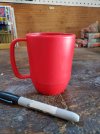When preparing for The Field we would only pack what we needed, throw out half of it and then it would only be grub and ammunition.
He should visit his barber before departure and leave the requirement for shampoo and conditioner on the barber shop floor, by the time he returns, his hair will be two inches long again. Also, leave the razor behind, if he doesn't already have a beard, he'll have a fine start of one when he returns.
What you need and what you want are two different things.
What he will need;
1 Fleece Jumper
2 T Shirts
2 Pairs of Underpants (Step Ones are excellent at preventing inner thigh scurge)
1 Pair of Shorts
1 Pair of Trousers/Shorts convertibles
3 Pair of Socks (change socks and dust feet half way in the day)
1 Pair of Walking Boots or Shoes
1 Pair of Walking Sandals
1 Set of Rain Gear
1 Good Umbrella
1 Hat (if he wears one)
1 Pair of Speedos
1 Something to sleep in
1 Bar of Carbolic or Coal Tar Soap (Lifebouy)
1 Bar of Washing Soap (Sunlight)
1 Microfibre Towel Large
1 Tube of Toothpaste (half full)
1 Toothbrush and Floss
1 Prophylactic (you never know)
10 Clothes Pegs
10 Nappy Safety Pins (to hang your washing on your pack)
1 Small Wet Wipes for when you're caught short
6 Zip Loc Bags to prevent valuables (credential, passport) from getting wet
1 Housewife (sewing kit)
1 First Aid Kit (plasters, adhesive dressings, ointment, salve, disinfectant, anti-biotic powder)
1 Foot Powder
1 .5 Litre Water Bottle
1 Bum Bag/Fanny Pack
1 Guide Book or the ability to make friends with someone that has a guide book
What he might want;
1 Phone c/w charger
1 Tablet c/w charger
1 Head Lamp
1 Hoop (just in case he meets anyone that would require him to jump through a hoop)
1 Handle (just in case he needs to Fly off the Handle)
1 Conclusion (if one has to jump to a conclusion, it is preferable to have a conclusion close to hand)
1 Ball of String
1 Deck of Cards (you never know when a game of Don, Hearts, A 110 or Lives might happen)
and finally and I can not stress this enough;
1 Good Attitude
1 Friendly Disposition
On getting into the Albergue, first shower and change clothes, wash clothes and hang to dry. If they are not dry and the next day is good, safety pin them to your pack to dry as you walk. If the next day is to be wet put them into a plastic bag and take them into the sleeping bag to warm them up and change into the damp ones and hit the road immediately. Keep a set of clothes dry to change into when you're finished walking for the day. Sitting in wet clothes in the evening will wreck you. If the boots are wet, ask in the bars for old newspapers to dry the boots. Though, in this day and age, newspaper might be in short supply
Everyone here is advising you and you not going anywhere. You're just going to send him on his way with a pat on the back telling him he'll be grand, the Camino will provide, aren't ye?

















